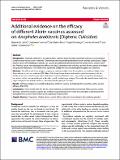Por favor, use este identificador para citar o enlazar a este item:
http://hdl.handle.net/10261/259338COMPARTIR / EXPORTAR:
 SHARE SHARE
 CORE
BASE CORE
BASE
|
|
| Visualizar otros formatos: MARC | Dublin Core | RDF | ORE | MODS | METS | DIDL | DATACITE | |

| Título: | Additional evidence on the efficacy of different Akirin vaccines assessed on Anopheles arabiensis (Diptera: Culicidae) |
Autor: | Letinić, Blaženka D.; Contreras, Marinela CSIC ORCID; Dahan-Moss, Yael; Linnekugel, Ingrid; Fuente, José de la CSIC ORCID ; Koekemoer, Lizette L. | Fecha de publicación: | 2021 | Editor: | BioMed Central | Citación: | Parasites and Vectors 14: 209 (2021) | Resumen: | [Background]: Anopheles arabiensis is an opportunistic malaria vector that rests and feeds outdoors, circumventing current indoor vector control methods. Furthermore, this vector will readily feed on both animals and humans. Targeting this vector while feeding on animals can provide an additional intervention for the current vector control activities. Previous results have displayed the efficacy of using Subolesin/Akirin ortholog vaccines for the control of multiple ectoparasite infestations. This made Akirin a potential antigen for vaccine development against An. arabiensis. [Methods]: The efficacy of three antigens, namely recombinant Akirin from An. arabiensis, recombinant Akirin from Aedes albopictus, and recombinant Q38 (Akirin/Subolesin chimera) were evaluated as novel interventions for An. arabiensis vector control. Immunisation trials were conducted based on the concept that mosquitoes feeding on vaccinated balb/c mice would ingest antibodies specific to the target antigen. The antibodies would interact with the target antigen in the arthropod vector, subsequently disrupting its function. [Results]: All three antigens successfully reduced An. arabiensis survival and reproductive capacities, with a vaccine efficacy of 68–73%. [Conclusions]: These results were the first to show that hosts vaccinated with recombinant Akirin vaccines could develop a protective response against this outdoor malaria transmission vector, thus providing a step towards the development of a novel intervention for An. arabiensis vector control. |
Versión del editor: | https://doi.org/10.1186/s13071-021-04711-8 | URI: | http://hdl.handle.net/10261/259338 | DOI: | 10.1186/s13071-021-04711-8 | E-ISSN: | 1756-3305 |
| Aparece en las colecciones: | (IREC) Artículos |
Ficheros en este ítem:
| Fichero | Descripción | Tamaño | Formato | |
|---|---|---|---|---|
| additionarabi.pdf | 1,12 MB | Adobe PDF |  Visualizar/Abrir |
CORE Recommender
SCOPUSTM
Citations
3
checked on 19-abr-2024
WEB OF SCIENCETM
Citations
1
checked on 26-feb-2024
Page view(s)
38
checked on 23-abr-2024
Download(s)
42
checked on 23-abr-2024
Google ScholarTM
Check
Altmetric
Altmetric
Este item está licenciado bajo una Licencia Creative Commons

